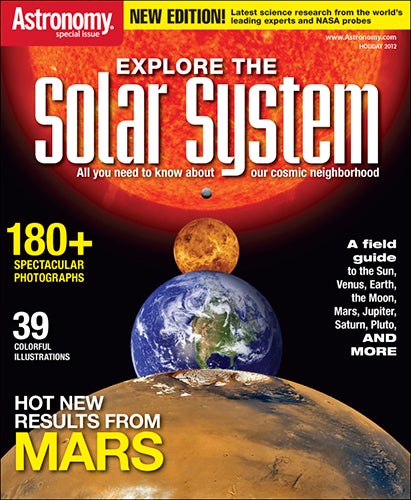
Waukesha, Wis. — This is a golden age for planetary exploration. Although we may be a long way off from sending humans to physically roam another world in our solar system, the robots we’ve sent instead have served admirably. That was true when the editors of Astronomy released The Solar System special issue in 2008, and if anything it’s truer now for this updated edition, Explore the Solar System.
Nearly every major body in our little corner of the galaxy has a probe in tow or en route. The missions already underway four years ago have made exciting new discoveries, and those then on their way have either arrived or are that much closer to their destinations. So it’s time for an update to our guide to “everything you’ve ever wanted to know about the solar system.”
Most recently, and spectacularly, NASA’s Curiosity Mars rover has begun exploring the Red Planet to determine if the environment could harbor life. From its perfect landing August 6 to its stunning landscape photographs, the car-sized rover will answer questions — and almost certainly pose new ones — for years to come about our ruddy neighbor. Should it find evidence of habitability on Mars, or even habitable conditions, how we see the Red Planet will never be the same.
But as Curiosity and its robotic colleagues explore Mars, we’re slowly uncovering answers to questions about the rest of the solar system as well. The Sun nears the maximum of its current solar cycle, and NASA’s Solar Dynamics Observatory is there to witness every detail. The MESSENGER probe continues its unprecedented work studying Mercury, the innermost planet. The Cassini mission’s fantastic and otherworldly images support Saturn’s title of “most beautiful planet.” And the coming years also will see the arrival of new unmanned observatories at Jupiter, Pluto, and the asteroid Ceres.
The solar system is a fascinating place, full of the familiar (such as the near ubiquity of water) and the peculiar (such as Uranus’ unique sideways rotation). As scientists learn more about our extraterrestrial surroundings from the various missions, let Explore the Solar System serve as your guide to the far-flung family of planets, moons, rocks, and one average star that make up our cosmic neighborhood.
These 16 articles cover it all, from the smallest planet to the biggest, the innermost worlds to the outermost bodies, the origins of the Sun and planets to their present-day locations in the sky. Each features the most up-to-date information — including, of course, the latest dazzling photos — and the expertise of authors who are the foremost authorities in each subject.
And what amazing subjects they are. As Curiosity’s landing kicks off another chapter of this golden age, it’s important to keep the Red Planet in perspective. Mars is certainly a fascinating world, perhaps soon to become even more so, depending on what the rover finds. But as I hope you’ll see, it’s just one of the many amazing destinations we’ve discovered in the solar system we call home.
Explore the Solar System is available at Barnes & Noble, Books•A•Million, and many other bookstores and newsstands around the world, as well as Walmart, Target, and most major supermarket chains in the U.S. and Canada. For more information or to order directly from Kalmbach Publishing Co., call 800-533-6644 or visit www.Astronomy.com/AS6.









